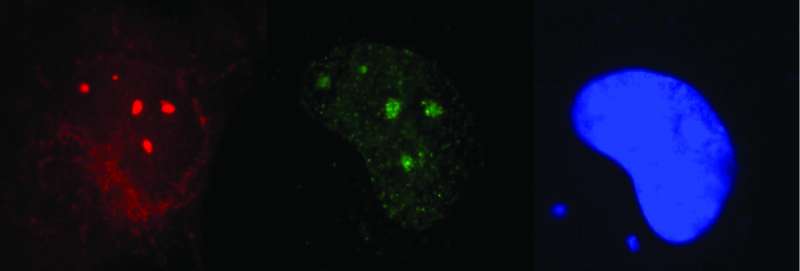Diabetes drug helps repair UV-damaged DNA in cells of 'Moon children'

The severe and debilitating genetic disease Xeroderma pigmentosum impedes cells to repair UV-induced DNA damage. Scientists from CeMM found a drug approved for diabetes treatment to alleviate the impact of the gene defect in cell culture, which led to the discovery of a previously unknown DNA repair mechanism. The study was published in Molecular Cell.
The destructive force of UV radiation on DNA molecules is only fully visible, when repair mechanisms fail: patients with the rare genetic disease Xeroderma pigmentosum - also known as "Moon children' - develop inflammations upon exposure to only small amounts of sunlight, rough-surfaced growths and eventually skin cancer occurs often in early age. The severe condition is caused by mutations in the genes for the nucleotide excision repair (NER) pathway - the only known mechanism that deals with UV-induced DNA damage in human cells. Although first described in 1874, Xeroderma pigmentosum to date lacks any curative treatment.
Led by Joanna Loizou, Principal Investigator at the CeMM Research Center for Molecular Medicine of the Austrian Academy of Sciences, and together with collaborators from the Medical University of Vienna and the IRB Barcelona, the scientists at CeMM found in their most recent publication that the FDA-approved diabetes drug acetohexamide significantly improves the resilience of NER deficient cells against UV radiation in vitro. Above that, the study published in Molecular Cell identified the responsible molecular mode of action - a hitherto unknown, NER-independent repair mechanism for UV-induced DNA damage. The study has not tested the use of acetohexamide in Xeroderma pigmentosum patients.
For their study, the scientists of Loizou's team developed a special chemical screening approach for compounds that would allow Xeroderma pigmentosum-disease cells to survival UV treatment better. Using the CLOUD (Cemm Library of Unique Drugs), this approach led to the identification of acetohexamide: By treating Xeroderma pigmentosum-disease cells with the diabetes drug, these cells could now repair UV-induced DNA damage more efficiently. A multitude of subsequent experiments eventually led to the elucidation of the underlying molecular mechanism: acetohexamide leads to the degradation of the DNA repair enzyme MUTYH, triggering an hitherto unknown NER-independent mechanism for removing UV-induced DNA damage.
"MUTYH has not been previously implicated in the removal of UV-induced lesions," emphazises Abdelghani Mazouzi, first author of the study. "However, our data collectively show that the anti-diabetic drug acetohexamide can alleviate the sensitivity of NER-deficient cells and enhance the repair of UV lesions through the degradation of MUTYH." "Loss of MUTYH allows Xeroderma pigmentosum-disease cells to deal with UV-induced DNA damage more proficiently" Joanna Loizou summarizes. "Those findings are not only a valuable contribution to the fundamental, molecular understanding of DNA repair, but could also pave the way for a novel therapeutic approach for this severe and debilitating disease, for which there is no curative treatment".
More information: Abdelghani Mazouzi et al, Repair of UV-Induced DNA Damage Independent of Nucleotide Excision Repair Is Masked by MUTYH, Molecular Cell (2017). DOI: 10.1016/j.molcel.2017.10.021
Journal information: Molecular Cell
Provided by CeMM Research Center for Molecular Medicine of the Austrian Academy of Sciences

















